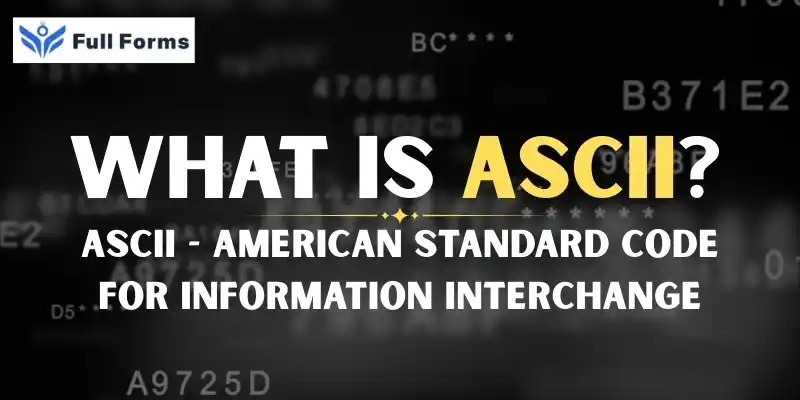American Standard Code for Information Interchange
(ASCII)

Description
What’s ASCII? It’s kind of the quiet hero behind all the digital text stuff you see every day.
We spend hours typing, messaging emailing, web browsing, and code writing in the digital age. But have you ever considered how your computer knows what you are typing? How does it discern between the letter “A” and the number “9” or the exclamation mark and space? The answer is something simple yet vital: ASCII — American Standard Code for Information Interchange.
ASCII: A great and very important standard that most people don’t know about, but which is utterly foundational to all the digital communication we take for granted every day.
It stands for American Standard Code for Information Interchange, and it is a character-encoding standard from the early 1960s. Its goal was to provide a standard way for computers to represent text using numbers. Every letter, number, or symbol one keys on the keyboard is associated with a number in ASCII.
For example:
- ‘A’ has a value of 65.
- ‘a’ is 97. then ‘1’ equates to 49.
- One space is 32.
ASCII has 128 standard characters, including:
- 33 control characters, e.g., BS (backspace), HT (horizontal tab), NL (new line feed),
- 26 UC letters (A to Z),
- 26 LC letters (a to z),
- 10 figures (0-9),
- and 33 special characters such as @, #, $, % etc
So each character needs 7 bits of memory. This was ideally suited for the early computers which were generally having very small memory space.
Why ASCII was made?
Years ago there was a big problem with computers, which is that not all systems displayed characters the same way, so a file written on one computer may not be readable on another. Not standardizing made things hard to understand and slowed things down.
ASCII is a code standard for electronic communication established jointly by the U.S. Government and businesses. They ‘gave birth’ of ASCII in 1963. By 1967, it was the foundation for nearly all systems- and computers text-based communications.
It made early mainframes, teleprinters, and later personal computers ‘converse’ with each other in the same language, ASCII.
How ASCII is Applied in Practice
ASCII is alive and kicking today, although the more advanced encoding formats used are in newer systems, like UTF-8. Here's where you might see it in action:
- Programming languages
A great number of programming languages apply ASCII as their base text format. Hence, if you type ‘if (x == ‘A’)’, computers perceive ‘A’ as 65. - Web pages
HTML and JavaScript use ASCII codes to render content or handle inputs. You may have noticed such characters as @ when they stand for @— that’s the ASCII code. - File Types
Most basic text files (.txt) are encoded in ASCII. These files can be used by almost any device or program. - Network and internet protocols
ASCII is at heart of early systems. They are systems for communication like email HTTP protocols, and file transfers like FTP. Even today, a lot of headers and commands still use ASCII. - Data Communication
Many old industrial hardware embedded systems sensors ‘s architectures communicate using ASCII characters.
Limitations of ASCII
While ASCII was a giant step for the time it was also a rather limiting step:
- Not inclusive: AT&T Bell Laboratories made ASCII primarily for the English language and hence did not include many of the various languages in the world.
- Other character encodings, such as Extended ASCII (256 characters), and Unicode (over 140,000 characters) came later to solve this problem. The first 128 characters of Unicode are the same as standard ASCII, so it is all still rooted in ASCII.
Why ASCIIs still important:
Why should you care about some ancient character set standard from the 1960s? The answer is simple - it Still plays an important role in today's computers
So ASCII reminds us of all these needs: efficient, straightforward, and obeying the rules. It laid the foundation for how computer language operates in respect to text. Thus, it allowed computers, OSs, and even different countries to ”speak” ‘’the same digital language.”
This means of learning is also beneficial to those who have just started programming or are beginners in technology. If one understands ASCII, they will be able to comprehend the working of a computer a little more, like how it deals in converting letters into numbers and vice versa.
ASCII is a mere 128 characters long, but it packs a heck of a punch. It’s the silent intermediary between human language and machine understanding, a standard that contributed to molding the entire digital age. ASCII is still a symbol (no pun intended) of how the simplest ideas can have the biggest effects even though technology keeps changing.
So next time you type up a message or some code just remember in the background ASCII may be working to ensure everything’s understood one character at a time.
